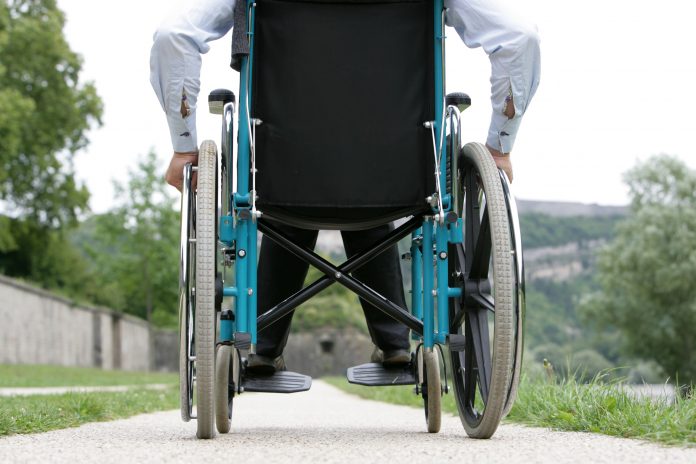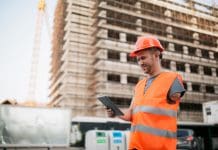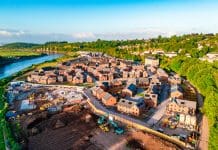Access consultant, Ian Streets says we must not forget disabled people when planning for social distancing
Nationwide, teams of designers and construction workers are devising and delivering new business environments in offices, shops and factories, on public transport and in the public realm, soon to be let loose to do the same in bars, clubs and restaurants in line with social distancing measures.
It’s all about making the essential adjustments needed to get the country back to work after the coronavirus lockdown and – without wanting to doubt the importance of that for a second – it’s to be hoped that employers will also recognise the parallels with making reasonable adjustments to improve accessibility for disabled people.
The procedure is much the same, as is the ultimate aim – making routes and spaces safe for use by as many people as possible.
In cases that we’re aware of, employers whose premises have fallen silent since the start of the lockdown have gone to great lengths to make the workspace safe.
They have toured their sites and scrutinised the layout and facilities every step of the way because they recognise that every business owner knows their own company better than anybody else, and official guidance can only become specific when it is applied properly.
Making changes
Typically the approach to making changes will be based on input from all the departments within a business and the outcome may be finding a different way of working by adopting sensible, practical solutons that aren’t too technical or too costly – but which can become very expensive if they are overlooked.
It should cover the journey through the premises and through the working day, thinking about how the employees arrive at work and anticipating all the touch points and interactions before home time.
In tackling coronavirus, businesses are re-designing walkways into a one-way system with two-metre markers and passing points for people and vehicles. They’re introducing mobile wash stations and water fountains to cut out unnecessary journeys around the site.
We’re aware of cases where the staff toilet rooms only had one door so employers have knocked holes in walls to separate the entrance from the exit. And there’s new signage everywhere giving constant reminders about social distancing – use the one way system and keep washing your hands.
Production cells are being reconfigured to ensure there is enough space for workers to operate safely. It’s all considered to be practical stuff that’s just common sense.
With changes in place the more alert businesses then walked the site and found things that triggered new ideas. Even when they were confident about bringing staff back for a phased return to work they consulted with colleagues first, and they are keeping the conversation going with a system of daily reviews and weekly forums.
Communication & collaboration
Businesses are also communicating with others and learning from what neighbours, suppliers, customers and competitors are doing. It gets to the point where they look and learn everywhere they go, seeing examples of good practice whether they’re visiting another business or just doing the shopping, and trying them out back at their own workplace.
All of this is being done to make the businesses more productive more quickly by enabling highly-valued staff to return to work and by putting the company in a position to welcome back customers and visitors whether it’s for meetings, interviews, fixing things, selling things, buying things, eating, drinking, shopping or whatever.
It should ring a few bells because much of this also applies to the needs of disabled people, just perhaps not as drastically right now or with the same degree of urgency.
What these businesses have basically done is carried out an access audit of their premises and identified areas that need attention in order to facilitate that return to work.
Access audits
It’s not quite the same as one of our access audits because it focuses more on the needs of non-disabled workers whose attendance and activity is limited by a unique set of circumstances.
But the process must of course consider the requirements within this scenario of people who have an impairment, and in reviewing those routes and facilities it makes sense to consider whether they provide good accessibility in normal circumstances.
If you’ve got a pinch point in a doorway or corridor there’s every chance it will present difficulties every day for someone who uses a wheelchair. Is there an alternative route? If so, is it accessible?
What is the impact likely to be on disabled staff or visitors if the measures to maintain social distancing for you to reduce the capacity of any lifts in your building?
If you’re installing hand sanitiser stations and water fountains are they suitable for use by disabled people, and is it worth keeping them permanently?
If you’re knocking holes in the walls of toilet areas does that present an opportunity to carry out other structural improvements – maybe make sure the accessible WCs are up to standard?
If you’re removing clutter in a shop or shifting things around to widen the aisles it’s likely the new environment will be more accessible, in which case why not stick with that? But don’t jump to conclusions. If increasing the floor space means sticking another shelf of products on top of existing displays you may be creating a whole new problem.
And if you’re putting up new signage, make sure it’s designed and located with disabled people in mind.
About Access














